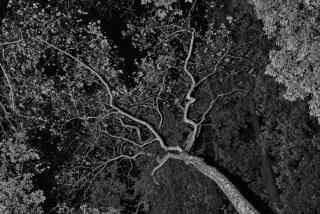Hachiya persimmon: The taste and look of fall
- Share via
Come fall in Southern California, they are markers of the season: persimmons hanging on the tree, even as leaves are dropping. Some varieties can hold fruit until Christmas.
Originating in China and cultivated extensively in Japan, the persimmon (Diospyros kaki) comes in thousands of varieties. They vary in taste, shape and ripening calendar, but for the backyard grower, the choice boils down to Fuyu and Hachiya.
The former can be eaten right off the tree, ripening up as crisp and sweet as an apple once the round fruit gets more orange than yellow.
The acorn-shaped Hachiya, on the other hand, stays astringent in taste until the fruit ripens fully, turning red-orange and squishy to the touch.
Echo Park actor Jan Munroe likes the Hachiya. He picks them when they’re nearly gelatinous, puts them in the freezer for a day and then eats them like sherbet, with a spoon. The fruit comes from a neighbor’s tree because Munroe hasn’t had luck with his.
He just planted a Hachiya -- his third attempt. The dogs destroyed the last one, chewing on the sweet bark, so he put up a fence. He also dug a deeper planting hole along with a trench for feeding and deep soaking.
You can plant persimmons any time of the year, but bare root trees -- the less expensive option -- are best planted during winter dormancy. They are available from OSH and Home Depot, among other places.
Persimmons are easy to grow. They don’t require pollinating, are drought resistant and can adapt to containers. They can be kept low or espaliered for easy harvest.
Winter is also the time to prune like an engineer -- or artist. Carefully taking out the smaller twigs will open up the center and balance the tree’s structure. Next year’s fruit develops on the tips of last year’s growth, and overloaded branches can break in strong winds. Excessive nitrogen fertilizing can lead to early dropping of fruit.
The primary pests are birds and squirrels. The trees don’t like being close to eucalyptus.
And if planting and the harvest go fine, but you find yourself with Hachiya that’s still too firm to eat, put it in a bowl with a ripe banana. That will speed things up.
The Global Garden, our series looking at this multicultural city through the lens of its landscapes, usually appears here on Tuesdays. We welcome story suggestions at [email protected].
More to Read
Eat your way across L.A.
Get our weekly Tasting Notes newsletter for reviews, news and more.
You may occasionally receive promotional content from the Los Angeles Times.










